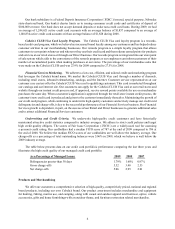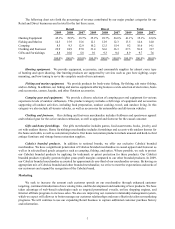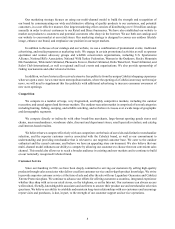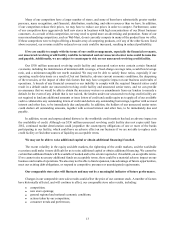Cabela's 2009 Annual Report Download - page 24
Download and view the complete annual report
Please find page 24 of the 2009 Cabela's annual report below. You can navigate through the pages in the report by either clicking on the pages listed below, or by using the keyword search tool below to find specific information within the annual report.15
We may not be able to sustain the growth in the number of our retail stores, the revenue growth historically
achieved by our retail stores, or to maintain consistent levels of profitability in our Retail business, particularly
as we expand into markets now served by other large-format sporting goods retailers and mass merchandisers. In
particular, new retail stores typically generate lower operating margins because pre-opening costs are fully expensed
in the year of opening and because fixed costs, as a percentage of revenue, are higher. In addition, the substantial
management time and resources which our retail store expansion strategy requires may result in disruption to our
existing business operations which may harm our profitability.
The slower pace of our retail store expansion may negatively impact our revenue growth and
profitability.
The opening of new retail stores has contributed significantly to the growth of our merchandising revenue.
As part of our efforts to improve retail operations, and in light of the challenging macroeconomic environment
facing retailers, we made the strategic decision to slow the pace of our retail store expansion. We opened eight new
retail stores in 2007, two new retail stores in 2008, one new retail store in 2009, and currently plan to open one new
retail store in 2010. The slower pace of our retail store expansion may negatively impact our revenue growth and
profitability.
Retail store expansion could adversely affect the operating results of our Retail business and reduce the
revenue of our Direct business.
As the number of our retail stores increases, our stores will become more highly concentrated in the geographic
regions we serve. As a result, the number of customers and related revenue at individual stores may decline and the
average amount of sales per square foot at our stores may be reduced. In addition, as we open more retail stores and
as our competitors open stores with similar formats, our retail store format may become less unique and may be less
attractive to customers as tourist and entertainment shopping locations. If either of these events occurs, the operating
results of our Retail business could be adversely affected. The growth in the number of our retail stores may also
draw customers away from our Direct business. If we are unable to properly manage the relationship between our
Direct business and our Retail business, the revenue of our Direct business could be adversely affected.
Our failure to successfully manage our Direct business could have a material adverse effect on our
operating results and cash flows.
During 2009, our Direct business accounted for 43.3% of the total revenue in our Retail and Direct businesses.
Our Direct business is subject to a number of risks and uncertainties, some of which are beyond our control, including
the following:
• our inability to properly adjust the fixed costs of a catalog mailing to reflect subsequent sales of the products
marketed in the catalog;
• lower and less predictable response rates for catalogs sent to prospective customers;
• increases in U.S. Postal Service rates, paper costs, and printing costs resulting in higher catalog production
costs and lower profits for our Direct business;
• failures to properly design, print, and mail our catalogs in a timely manner;
• failures to introduce new catalog titles;
• failures to timely fill customer orders;
• changes in consumer preferences, willingness to purchase goods through catalogs or the Internet, weak
economic conditions and economic uncertainty, and unseasonal weather in key geographic markets;
• increases in software filters that may inhibit our ability to market our products through e-mail messages to
our customers and increases in consumer privacy concerns relating to the Internet;
• changes in applicable federal and state regulation;
• breaches of Internet security; and
• failures in our Internet infrastructure or the failure of systems of third parties, such as telephone or electric
power service, resulting in website downtime, customer care center closures, or other problems.
























